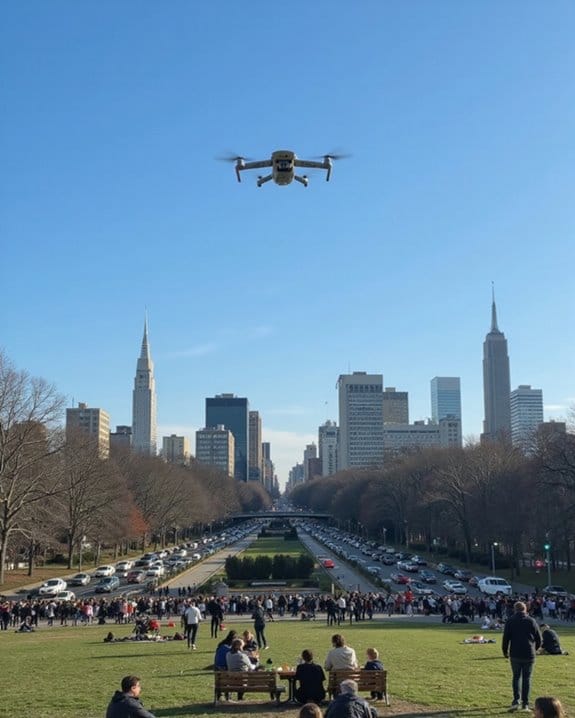You shouldn’t shoot down drones because it’s illegal—expect fines of thousands and up to 20 years behind bars if you do. It’s also risky: hit one, and you could cause fires, injury, or damage when that flying gadget crashes. Getting trigger-happy risks hitting manned aircraft, too, which could be tragic. Instead, experts suggest safer methods like signal jamming. Curious about how agencies, laws, and technology tackle rogue drones? There’s plenty more to unpack.
Key Takeaways
- Shooting down drones is illegal under federal and state law, carrying severe criminal penalties, including hefty fines and up to 20 years in prison.
- Downed drones can cause injuries, property damage, or fires due to falling debris and lithium battery explosions.
- Civilians often misidentify manned aircraft as drones, risking catastrophic crashes and loss of life if shot at.
- Government agencies recommend non-destructive responses, such as electronic jamming or documentation, to avoid escalation and safety hazards.
- Safer alternatives like signal jamming and drone capture are being adopted and legislated for authorized personnel to handle drone incidents.
Legal Penalties for Shooting at Drones
When it comes to shooting down drones, you might be surprised to learn that the legal consequences are a lot more serious than just a slap on the wrist. Under federal law, drones are classified as aircraft—even though they’re unmanned. If you’re caught shooting drones, you could face:
- Civil penalties: The FAA can fine you thousands for damaging or destroying an aircraft.
- Criminal charges from federal authorities: The Aircraft Sabotage Act carries up to 20 years in prison for endangering an aircraft.
- State laws: For example, in New York, shooting at drones is a felony, with up to 7 years in prison.
Pointing lasers at drones is also prohibited. These penalties aren’t just theoretical—they’re a real public safety threat deterrent. Instead, professionals rely on frequency jamming and GPS disruption to safely disable drones without physical harm.
Public Safety Hazards From Falling Drones
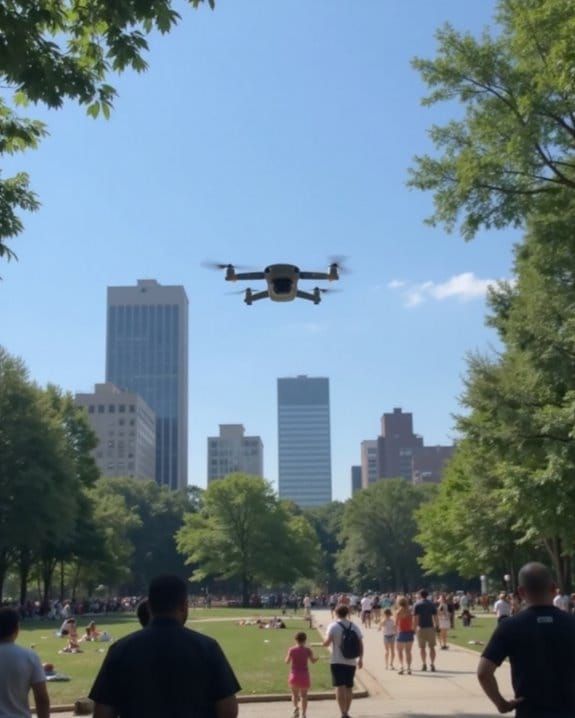
Legal trouble isn’t the only thing keeping people from taking aim at drones. Shooting at unmanned aircraft poses a significant safety risk, especially when those drones are flying dangerously close to homes or public areas. If the gunfire could crash a drone, you’re not just removing a nuisance—you’re creating an imminent threat. Debris from a downed drone can collide with other objects or fall onto persons or property, causing damage to persons, vehicles, and even critical infrastructure.
Key Hazards:
- Impact: Large drones, sometimes the size of a car, crashing onto property on the ground can cause severe injury or destruction.
- Batteries: Lithium batteries can ignite or explode on impact, increasing fire risk—think forests or neighborhoods.
- Chain Reaction: Falling objects in the air may trigger further accidents or fires.
Bottom line: It’s reckless, not heroic. Additionally, drone batteries often contain high-capacity lithium cells that pose significant fire hazards upon damage or impact.
Risks of Misidentifying Aircraft as Drones
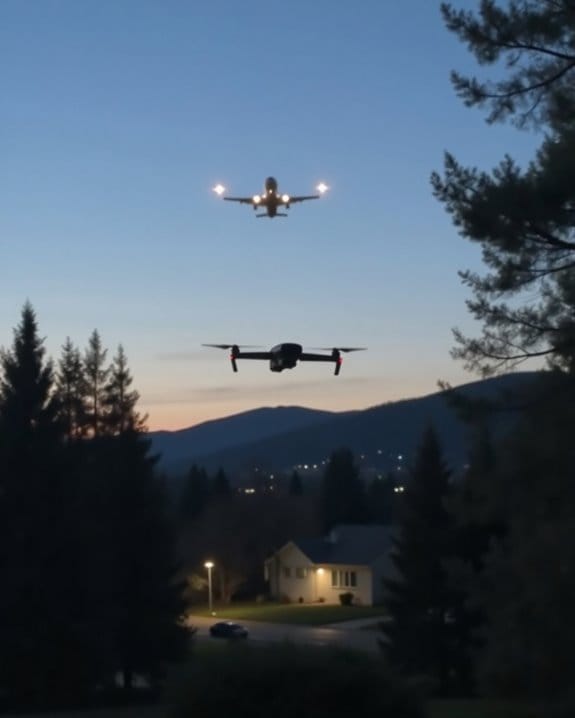
Ever wonder how easy it is to mistake a drone for something far more critical in the sky? With so many sightings reported, you might think mysterious drones are everywhere—but reports show that what people spot are often actually manned aircraft. According to the Department of Homeland Security and the Biden administration, civilians frequently misidentify planes or helicopters as unidentified drones. Here’s why shooting at a supposed drone is risky:
- Over 1 million drones are lawfully registered with the FAA, yet many “drones” are misreported.
- Shooting at an aircraft hit by gunfire—not just a drone—can cause crashes, endangering lives.
- Police or medevac helicopters have been mistaken for drones, escalating the danger.
Be cautious; what you think is a drone might not be. Additionally, manned drones incorporate redundant flight controls and automated emergency protocols to enhance pilot safety, highlighting the complexity behind these aircraft.
Official Warnings and Expert Advice

Spotting something unfamiliar overhead might make you uneasy, especially after hearing how easy it is to mistake ordinary aircraft for drones. Before you consider any calls to shoot, officials urge you to think twice. The Federal Aviation Administration (FAA) strictly prohibits shooting at any aircraft—including drones. Violating this can result in a hefty penalty from the FAA, criminal charges, and even up to 20 years in prison under federal law.
Let’s break down the practical advice:
- National security: Shooting drones may escalate risks, creating uncontrolled crashes or fires.
- Law enforcement: Agencies recommend documenting sightings with photos or videos rather than using force.
- Public safety: Experts stress that most drone sightings are misidentifications, so reacting aggressively puts security at risk.
How Authorities Are Responding to Drone Sightings
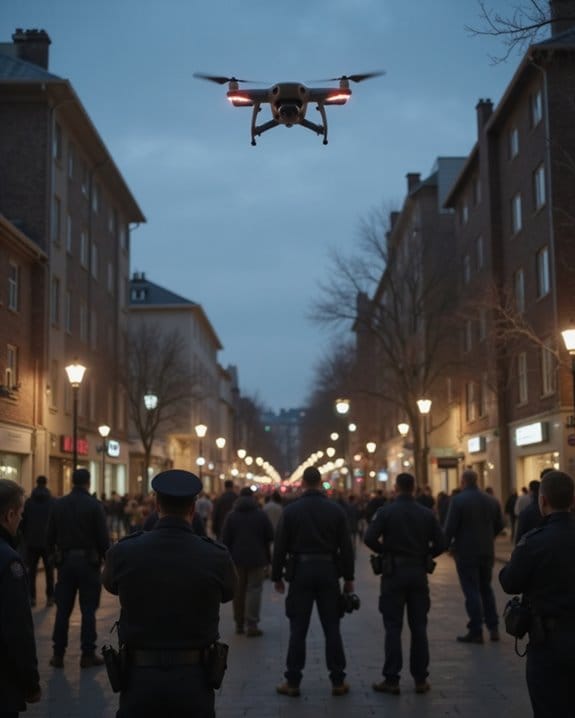
How do authorities tackle the rising number of drone sightings without causing more problems? You’ll notice federal agencies like the FBI and FAA teaming up with local law enforcement to keep tabs on drone activity. The White House, through national security spokesperson John Kirby, emphasizes that these sightings aren’t a national security threat. Instead of shooting drones down, agencies use non-kinetic methods—think electronic jamming and careful monitoring. The Pentagon’s approach is passive: detect, monitor, and avoid escalation.
Let’s break it down:
- FBI/DHS: Investigate reports, often finding manned aircraft are to blame.
- FAA: Coordinates airspace safety.
- Local Law Enforcement: Monitors and reports drone activity.
- State and Local Authorities: Still seeking broader authority to deal with incidents.
That’s smart risk management—no drone drama required.
Political and Legislative Moves to Address Drone Incidents

While federal agencies stick to careful monitoring and non-kinetic responses, the political stage is heating up with calls for tougher action on drones. Lawmakers like Chris Smith are pushing for House national security bills that give local governments more authority over unmanned aircraft system incidents, especially as sightings near military installations pose a national security risk. Senator Richard Blumenthal has even floated the idea to “shoot down the mystery” if drones threaten sensitive sites. Meanwhile, Kathy Hochul, New York’s Governor, is urging Congress to expand resources and state powers. The Federal Aviation Administration (FAA) may soon gain new abilities to seize or control rogue drones if the Counter-UAS Authority Security, Safety, and Reauthorization Act passes. Clearly, legislative momentum is building for a sharper response.
Alternatives to Shooting Down Unidentified Drones
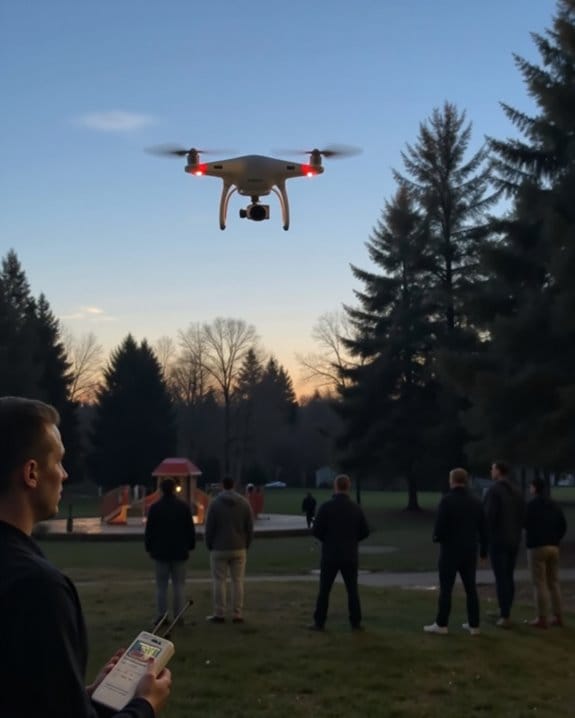
Ever wondered why you don’t see authorities reaching for rifles when a rogue drone buzzes overhead? Instead of risky shootdowns, agencies like the FAA and local police rely on advanced technology to counter mystery drones. Here’s a quick comparison of top alternatives:
1. Signal Jamming:
- Disrupts communication between unmanned aircraft and operators
- Enabled by the Preventing Emerging Threats Act of 2018
2. Remote Disconnection:
– Non-destructive, cuts off control link safely
3. Drone Seizure/Confiscation:
- Proposed by the Counter-UAS Authority Act
- Lets authorities take control of unmanned aerial systems
4. Electronic & Net Capture:
- Military and critical infrastructure use nets or electronic disables
- Reduces risk to people and property
5. Detection Devices:
– Tracks reported drone sightings via radio waves
Shooting’s old-school; tech is the new sheriff in town.
Frequently Asked Questions
Can Drones Be Hacked or Disabled Remotely Instead of Being Shot Down?
Did you know about 70% of consumer drones lack strong security? You can hack or disable many remotely with the right tech, like signal jammers or software attacks, but it’s illegal in most places, so don’t try it.
What Technologies Exist to Detect Drones Before They Become a Problem?
You’ve got several technologies to spot drones early—radar, radio frequency (RF) sensors, acoustic detectors, and optical cameras. These systems let you detect, track, and identify drones before they get too close or become a threat.
Are There Safe Zones Where Drones Are Not Allowed to Fly?
Yes, there are safe zones where you can’t fly drones, like near airports, military bases, or national parks. You’ll need to check local regulations and use apps or maps to stay updated on no-fly zones.
How Can Citizens Report Suspicious Drone Activity Effectively?
Think of reporting drones like calling in a strange car parked outside your house—you’d note details. So, you should record video, note time, and location, then contact local authorities or use official drone reporting tools for accuracy.
What Steps Are Being Taken to Improve Drone Identification for the Public?
You’ll see new technology like remote ID systems being rolled out, making it easier to identify drones. Authorities are also launching public awareness campaigns so you’ll know what to look for and how to report suspicious activity.


